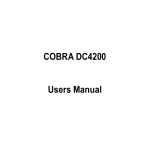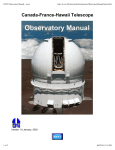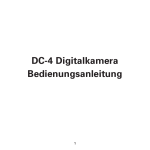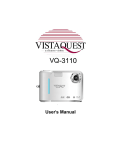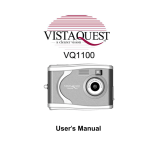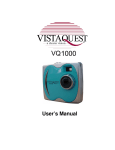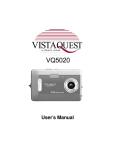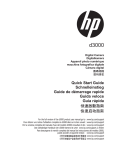Download VistaQuest VQ-2000 User's Manual
Transcript
User’s Manual 1 Contents 1 Introduction------------------------------------------------------------------------------------- 1 Overview---------------------------------------------------------------------------------------- 1 Warnings and Precautions----------------------------------------------------------------- 1 Package Contents---------------------------------------------------------------------------- 3 System Requirements----------------------------------------------------------------------- 3 Camera Features----------------------------------------------------------------------------- 4 2 Installing the Batteries----------------------------------------------------------------------- 5 3 Insert/Remove SD/MMC Memory Cards----------------------------------------------- 6 4 Capturing Images----------------------------------------------------------------------------- 7 Power On the camera ----------------------------------------------------------------------- 7 Power Off the camera ----------------------------------------------------------------------- 7 5 Camera Status Icons ------------------------------------------------------------------------ 8 6 Display Information and flows------------------------------------------------------------- 9 7 Capture an Image---------------------------------------------------------------------------- 12 8 Using Flash Light----------------------------------------------------------------------------- 12 9 Self-Time---------------------------------------------------------------------------------------- 13 10 AVI Capture------------------------------------------------------------------------------------ 13 11 Continuous Capture-------------------------------------------------------------------------- 14 -1- 12 Deleting Images------------------------------------------------------------------------------- 14 Delete the Last Image----------------------------------------------------------------------- 14 Delete All Images----------------------------------------------------------------------------- 14 Techniques for Capturing the Best Images--------------------------------------------- 14 13 Installing Camera’s Driver and Software------------------------------------------------ 16 14 Uninstalling Software and Camera’s Driver-------------------------------------------- 17 Uninstalling Software------------------------------------------------------------------------ 17 Uninstalling Camera’s Driver-------------------------------------------------------------- 17 Downloading Images to A Computer----------------------------------------------------- 18 For Windows 98/me customers----------------------------------------------------------- 18 For Windows XP------------------------------------------------------------------------------ 18 For Windows 2000/me/98------------------------------------------------------------------ 18 16 Arsoft PhotoImpression 5------------------------------------------------------------------- 19 17 Arcsoft VideoImpression 2----------------------------------------------------------------- 21 18 Using VQ2000 In PC-Cam Mode--------------------------------------------------------- 23 19 Checking the Connecting of Your VQ2000 -------------------------------------------- 23 20 Internet Video Conferencing------------------------------------------- 24 21 Using the Camera with NetMeeting------------------------------------------------------ 25 22 Specifications---------------------------------------------------------------------------------- 26 23 Attached Leaflet------------------------------------------------------------------------------- 27 15 -2- 020606 WARNING When the battery icon is blinking, download the pictures to your computer, immediately, and change the batteries; otherwise, your images will be lost. -3- 1. Introduction Overview Thank you for purchasing a VistaQuest digital camera. It can capture digital images, short video-clips (continuous shooting mode), and it can also serve as a PC/Web camera. The camera is equipped with 8 MB of memory to store your images and movie clips. You may download your images and movie clips to your computer using the USB cable and included software. Warnings and Precautions FCC STATEMENT This device complies with Part 15 of the FCC Rules. Operation is subject to the following two conditions: 1. This device may not cause harmful interference, and 2. This device must accept any interference received, including interference that may cause undesired operation. Note: This equipment has been tested and found to comply with the limits for Class B digital devices, pursuant to Part 15 of the FCC rules. These limits are designed to provide reasonable protection against harmful interference in a residential installation. This equipment generates, uses and can radiate radio frequency energy and, if not installed and used in accordance with the instructions, may cause harmful interference to radio communications. However, there is no guarantee that interference will not occur in a particular installation. If this equipment does cause harmful interference to radio or television reception, which can be determined by turning the equipment off and on, the user is encouraged to try to correct the interference by one or more of the following measures: 1. Reorient or relocate the receiving antenna 2. Increase the separation between the equipment and receiver 3. Connect the equipment into an outlet on a circuit different from that to which the receiver is connected 4. Consult the dealer or an experienced radio/TV technician for help. 1 Use of shielded cable is required to comply with Class B limits in Subpart B of Part 15 of the FCC rules. Do not make any changes or modifications to the equipment unless otherwise specified in the manual. If such changes or modifications should be made, you could be required to stop operation of the equipment. GENERAL WARNINGS – Do not use batteries other than those specified for use with the camera. The use of unsuitable batteries may result in the batteries splitting or leaking and causing a fire, injury, or soiling of the battery compartment. When placing batteries in the camera, check the polarity of the batteries (- and +) to ensure proper orientation. Incorrect polarity may result in the batteries splitting or leaking and causing a fire, injury, or soiling of the battery compartment. Remove the batteries if the camera will not be used for an extended period of time. The batteries may leak and cause a fire, injury or soiling of the battery compartment. If the batteries leak clean and wipe the battery compartment carefully and install new batteries. Wash your hands carefully if you touch the battery fluid. Please note that when you remove the batteries your images will be lost from the camera memory. WARNING: Handling the USB cable on this product may expose you to lead, a chemical known to the State of California to cause birth defects or other reproductive harm. Wash your hands after handling. TRADEMARK INFORMATION Microsoft® and Windows® are U.S. registered trademarks of Microsoft Corporation. Pentium® is a registered trademark of Intel Corporation. Other names and products may be trademarks or registered trademarks of their respective owner. 2 Package Contents 1. Camera 2. USB cable 3. Software 4. User’s Manual 5. Two AA batteries 6. Hand strap Note: Included components may vary, as specified by local retailers and locations. Check with your retailer for specifics. System Requirements You must use a computer to download the images from your camera. The computer that you use must meet the following minimum requirements: 1. Windows SE 98/Me/2000/XP 2. Direct X 8.0, or higher 3. 128 MB RAM 4. 60 MB hard disk space available 5. Available USB port 6. CD-ROM drive 3 Camera Features 1. Shutter Button 2. Flash 3. Viewfinder 4. USB Port 5. Lens 6. Self-Timer LED 7. Power/Mode Button 8. ENTER Button 9. Status LCD 10. Tripod Socket 11. Strap Eyelet 12. Battery Compartment Cover 4 2. Installing the Batteries Step 1: Open the battery door by lifting the tab on the door. Step 2: Insert two AA batteries with the polarity as Shown. Step 3: Close the battery cover. Warning: Do not open the battery door when the camera is powered ON. This will cause all images in memory to be lost immediately. If you open the battery door when the camera is OFF (when changing the batteries) you must close the door within thirty (30) seconds or your images will be erased from memory. Notes: 1. Always download your images to your computer soon after you have captured them. Never assume your images will be retained for more than three or four days. If the batteries are depleted, your images will be lost. 2. If you must change the batteries, makes sure the camera is OFF and then changes the batteries in less than thirty (30) seconds. 3. If you will not use the camera for a long time (several days, or more) remove the batteries. The batteries will discharge slowly if left in the camera. This may cause complete battery discharge as well as loss of images. The batteries may corrode if left in the camera for extended periods of time. 4. Dispose of batteries properly in accordance with local laws and regulations. Do not place them in fire. 5. The camera has an automatic power-saving feature. The camera will turn off automatically if it has not been used after approximately sixty (60) seconds. 6. When the camera is connected to a computer using a USB cable, it is not necessary to use batteries because the camera uses the power provided by the computer through the USB interface. 5 3. Insert/Remove SD/MMC Memory Cards The camera accepts a Secure Digital (SD) or a Multimedia Card (MMC) memory card up to 256MB capacity. The memory card takes priority over the internal memory. Whenever a memory card is inserted the camera will immediately use the memory card in preference to the internal memory. Therefore, when a memory card is inserted, the camera will store images and videos on the memory card. Likewise, the camera will playback images and videos that are stored on the memory card only. To access internal memory remove the memory card. Inserting a Memory Card Insert an SD or MMC card into the memory card slot located on the side of the camera, and gently press down with your finger. Removing a Memory Card Gently press down on the memory card and it will partially eject. Pull the card out with your fingers. Note: To use the internal memory (8MB), please remove the memory card first. 6 4. Capturing Images Using your new camera is fun and easy. There are two basic steps to capturing your first image. Step 1: Turn on the camera by pressing the Power/Mode button for two seconds. Step 2: Press the shutter button to capture an image. It is really that easy! The following sections will tell you about more features that are available on your camera. Power On the Camera To power on the camera pressing the Power/Mode as shown above. The camera will beep once, indicating that it is ready. The Status LCD display will turn on like this: button for two seconds In this example the camera is ready to capture image in Hi resolution mode. Note that the camera will automatically power-off after 10 seconds inactivity to save button. battery power. To turn the camera on again, press the Power Off the Camera button for five (5) seconds To turn the camera power OFF, press and hold the and the status LCD will shut off. Note: The camera will automatically power-off after 10 seconds of inactivity. 7 5. Camera Status Icons Beyond the basics of capturing an image, the camera has many other features. Turn on the camera and notice the many icons and symbols on the status LCD: As you press the Power/Mode button the LCD display will change in the following order. To learn more about each function refer to the referenced section in this User Manual. Camera Icons and Descriptions Icons Descriptions Number of images that you may capture in the available memory Movie Mode for capturing video clips Battery Indicator: 2 levels: Battery is full 1 levels: Battery is half full 0 levels : Battery is near empty; flash is disabled and the icons on the status LCD flashes 2408x1536: Take pictures about 3.2 M pixels. 1600x1200: Take pictures about 2.0M pixels (default) 1280x1024: Take pictures about 1.2M pixels 640x480: Take pictures about 0.3M pixels Erase one photo/video Erase all photos & videos Indicate the connecting of your camera and the computer Self-timer allows 10 seconds to capture an image SD Card: When a SD card is inserted in the camera it will show on the LCD display. Take pictures in large size (default) Take pictures in small size Flash off (default) Force flash Auto flash 8 6. Display Information and flows 1. Resolution Setting Press the Power/Mode button once. The LCD display will be as shown on the left. Press Power/Mode button repeatedly, the four stars (2408x1535) icon on the right top of the LED will change to one star (640x480) icon. Each time you are supposed to hold down Shutter button to confirm. 2. Self-timer Press the Power/Mode button four times. The LCD display will be as shown on the left. When the shutter button is pressed, the camera will shoot after beeping ten times. The function is ideal for getting yourself into the picture. 3. AVI Mode Press the Power/Mode button five times. The LCD display will be as shown on the left. When the shutter button is pressed, Press Shutter button to start playback of the AVI. Press Shutter again to stop the video playing. 4. Continuous Shooting Press the Power/Mode button six times. The LCD display will be as shown on the left. Three pictures will be taken in sequence after you press the shutter button. The counter will increase from 000 to 003. 9 5. Compression Rate Press the Power/Mode button seven times. The LCD display will be as shown on the left. Press the shutter button to confirm for shooting more images but small size. Press the Power/Mode button eight times. The LCD display will be as shown on the left. Press the shutter button to confirm for shooting few images but big size. 6. PC-Cam mode Press the Power/Mode button nine times. The LCD display will be as shown on the left. Connect your camera to the computer with the USB cable. 7. Frequency Setting Press the Power/Mode button ten times. The LCD display will be as shown on the left. Press the shutter button to confirm. You can set the frequency according to the frequency of local power mains. Press the Power/Mode button eleven times. The LCD display will be as shown on the left. Press the shutter button to confirm. You can set the frequency according to the frequency of local power mains. 10 8. Force flash 9. Auto flash 10. Flash Off Press the ENTER button once. The LCD display will be as shown on the left. Press the shutter button to confirm. Press the ENTER button twice. The LCD display will be as shown on the left. Press the shutter button to confirm. Press the ENTER button three times. The LCD display will be as shown on the left. Press the shutter button to confirm. 11. Delete One Picture Press the ENTER button still for two seconds times. The LCD display will be as shown on the left. Press the shutter button to delete the last picture in the camera. 12. Delete All Picture/Videos ON the basis of Delete One Picture settings. Press the ENTER button once. The LCD display will be as shown on the left. Press the shutter button to delete all the pictures in the camera. 11 7. Capture an Image In film-photography we say: “Take a Photo.” In digital-photography we say: “Capture an Image.” Capturing an image with this camera is easy. Step 1: Power on the camera and look through the viewfinder to frame your subject. Make sure your subject is no closer than three or four feet (one meter) or else it will not be in good focus. Step 2: Press the Shutter button to capture an image. The camera will beep once and the image counter will increase by one count. For example the counter may change from 000 to 001. The display counter shows the number of images to be taken. When the “FUL” warning message appears on the Info/Status LCD it means the memory is full and you must download your images or delete them to make more space available. Note: Please note that when batteries disconnected or discharged, the memory, and all taken pictures will be erased. 8. Using Flash Light When you take pictures at night, indoors or in gloomy conditions. Please use flash. Press the Enter button repeatedly to choose the flash options. (Please note the changing of the icon on the left bottom of the LCD.). Flash Off: the flash is off. (Default) Force Flash: the flash fires every time you take a picture, regardless of the lighting conditions. Auto Flash: the camera detects ambient lighting conditions, and the flash fires if it detects insufficient light. 12 9. Self-Timer If you would like to get into the image you may use the self-timer feature to delay image capture by ten (10) seconds. Place the camera on a tripod or a flat, stable surface. Turn on the camera. Press the Power/Mode button four times until the “ ” icon appears on the LCD display. Press the Shutter button the camera will beep as it counts down. The camera will capture an image automatically after 10 seconds. 10. AVI Capture You can capture motion-video clips using the AVI capture feature. The image is stored in AVI format. The image counter increments by one after movie clips are stored. Video clips are captured at a resolution of 320 x 240. The movie-clip frame rate will be approximately six frames per second. Movie clips are silent. (No audio.) To use the AVI capture mode follow these steps: Step 1: Power on the camera. Press the Power/Mode button five times until the “ icon appears on the LCD display. ” Step 2: Once the Shutter button is pressed, the camera will beep and the camera starts recording videos and the red LED will blink. Step 3: Press the Shutter button again to stop recording. The camera will stop recording automatically when the built-in memory is full. When the built-in memory is full, the word “FUL“ will be shown on the LCD display. Note: When you download a movie-clip it will be in the popular AVI format. Use Windows Media Player or Apple Quick Time Player to view movies. 13 11. Continuous Capture You can capture three images using the continuous capture feature. When you use this mode the image resolution will be 640 x 480. To use the Continuous Capture mode follow these steps: Step 1: Power on the camera. Press the Power/Mode button six times until the “ icon appears on the LCD display. ” Step 2: Press the Shutter button the camera will capture three images continuously. 12. Deleting Images You can delete the last image captured, or you may delete all images in memory. Delete the Last Image Power on camera. Press the Enter button still for two seconds times until the “ ” icon appears on the LCD display. Then press the shutter button to delete the last picture in the camera. (Example: 020 will change to 019.) Delete All Images Power on the camera. ON the basis of Delete One Picture settings. Press the Enter button once, the icon appears on the LCD display. Press the shutter button to delete all the pictures in the camera. Note: All Images will be deleted and the image counter will display 000. Techniques for Capturing the Best Images The camera can capture good images. Here are a few tips for getting the best possible images from your camera. 14 1. Use good lighting. The digital camera works best with adequate lighting. 2. Avoid uneven lighting and high contrast. Compose your scenes so that there are no deep shadows or bright backgrounds. The key to good images is balanced (even) scene lighting. Use the fill - flash for scenes where high contrast and dark shadows are unavoidable. 3. Minimum focus distance. Make sure your subject is not too close. The minimum focus distance is three to four feet (one meter.) 4. Position your primary subject in the center of the image. The camera focuses best in the center of the image. The edges of your images are softly focused, giving a nice soft perimeter effect to each image. 15 13. Installing Camera Drive and Software • Installing Driver 1.Turn on the computer. 2.Insert installation CD into the CD-ROM drive and the installation CD menu will appear. 3.When you see the following screen, choose “Camera Driver”. 4.Follow the on-screen instructions. 5.Restart the computer. For Windows 2000/XP only: During installation of the driver or software, computer may display the message: “The software you are going to install doesn’t contain the Microsoft signature, and may not work correctly. Do you want to continue? Y / N” Please select Y to continue the installation. • Installing Software 1.Insert installation CD into the CD-ROM drive and the installation CD menu should appear. 2.When you see the following screen, choose “Arcsoft Software” to install the software. 3.Follow the instructions on screen. 4.Installed software will automatically create “VideoImpression 2” or “PhotoImpression 5” logo on your desktop. 16 14. Uninstalling Software and Camera Driver The following instructions guide you to uninstall (remove) software from your computer. Uninstalling Software 1. Click “Start” from the task bar and choose “Settings->”Control Panel”. 2. (For Windows XP:”Start”->”Control Panels”) 3. Double click “Add/Remove Programs”. 4. Select the program to be uninstalled:”Arcsoft Software Suite”. 5. Click “Remove Program” (For Windows 2000/XP:”Change/Remove”) and then click “OK”. Uninstalling Camera’s Driver 1. Click “Start” from the task bar and choose “Settings”-> “Control Panel”. (For Windows XP:”Start”-> “Control Panels”). 2. Double click “Add? Remove Programs”. 3. Select the program to be uninstalled “MegaCam”. 4. Click “Remove Program” (For Windows 2000/XP:”Change/Remove”) and then click “OK”. 17 15. Downloading Images to a Computer For Windows 98/me customers: Please install VistaQuest digital camera driver before connecting. 1. Turn the camera and computer on, and then connect the camera to the computer with the included USB cable. 2. “USB Mass Storage drive” appears on the computer screen. For Windows XP: A dialogue box with options appears as shown on the Right side. The options are Play, Find/Fix/Share Images. Open folders to view files, take no action, Copy images to a folder on my computer, View a slide show of images, and etc. Please select one of them and click on “OK”. For Windows 2000/me/98: Double click on “My computer”, and then double click on Removable Disk (i:) in the DCIM files. (All the photos and videos are stored here). 3. Press “Ctrl+A” on the keyboard to choose all the photos/videos, and then press “Ctrl+C” to copy photos, and then open a file in the computer, press “Ctrl+V” to paste the photos. 18 16. Arsoft PhotoImpression 5 Arsoft PhotoImpression 5 is a complete digital image editing application designed with real people in mind. Easy-to-use “Getting Start” guides, User-friendly UI, complete image editing functionality, give users wonderful experience to organize view, enhance, edit, print and share photos. Click on “Start” “Program” “ArcSoft Software Suite” to PhotoImpression 5 and you will see a window as below. Select the photos source. For example Click “Folder” to acquire photos from your computer. Select the file path. You can start editing them now. 19 1. Get Photo – Choose how to view or acquire photos. 2. Enhance – Crop, brighten, rotate, resize and modify photos. 3. Create– Add clip art, special effects, frames and more. 4. Project – Make calendars, photo books and greeting cards. 5. Print – Print multiple images per page and multiple pages at one time. 6. Send – Email photos or upload them to online photo sharing accounts. Note: For detailed information, please refer to the Help of the program. 20 17. Arcsoft VideoImpression 2 VideoImpression creates home movies and slide shows by combining existing videos, still images, exciting scene transitions, and multiple audio tracks. Though simple to use, the program provides intense and broad video editing and export options perfect for owners of digital still cameras, desktop and digital video cameras, and camcorders. Click “Start” “Program” “ArcSoft Software Suit” “VideoImpression 2” to lauch VideoImpression 2 or double click VideoImpression 2 icon on the desktop and you will see a window as the screenshot below. Open a project – Let you browse the project files in the VideoImpression system folder. By “project” we mean to say a file that contains all of the settings and each individual component on the Storyboard. When you save your work as a project, you can go back and swap components add and remove them, alter audio, etc. Create a Video – Create a new video project. You can retrieve media materials from the device connected or choose media files from system folder. You can choose video materials from you photo album as well .Create a Slide Show – Create a slide show project. You can retrieve media materials from the device connected or choose media files from system folder. You can choose slide show materials from your photo album as well. If the box “always show this wizard when VideoImpression starts.” At the bottom of the wizard is checked, the wizard will appear each time you run the program. If you‘d like to skip the wizard next time, uncheck 21 the box. Select the item you desire or the picture, videos you need then you will enter the editing interface as below. You can use the six steps in the Function Menu to create video clips and slide shows. Media - Select the videos and images that will comprise your final movie or slide show. 2. Edit – Modify video, image color and adjust the duration of each movie component. Only available for video projects. 3. Effects – Add neat special effect transitions between each component or apply a pre-made theme. 4. Text – Place animated text on any movie component. Only available for video projects. 5. Narrate – Record audio directly from the program and it to your movie. 6. Produce – Combine all components to create your final videos; save it in a variety of ways or email it to friends. The Storyboard – The backbone of the creation process, it’s where you assemble your movie. The Player – Preview and modify your movies in this area. Working with Albums – Albums let you organize your media for easy access. Note: For detailed information, please refer to the Help pf the program. 1. 22 18. Using the Camera in PC-Cam Mode The camera offers two USB modes: Removable Disk and PC Camera. Note: Please install camera drive before you can use the camera in PC-Cam. Setting Up PC-Cam 1. 2. 3. 4. 5. Turn the camera power on. Press the Power/Mode button nine times to select PC-Cam mode. Connect the camera to the computer use the USB cable. Click on Start, Programs, MegaCam to start the PCCam The camera will start functioning as a PC camera. Or you may select “Options” -> “Preview” to begin the video function. 19. Checking the Connecting of Your Camera For Windows 98/Me only Double click “My Computer” icon -> Control Panel -> System -> Device -> Manager -> Imaging Device; when you See “MegaCam” that means now the camera is installed. For Windows 2000/Xp only Double click “My Computer” icon (Windows 2000) or go to Start button and select “My Computer” (Windows XP) -> Control Panel -> System -> Hardware -> Device Manager -> Imaging Device; when you see “MegaCam” that means now the camera is installed. 23 20. Internet Video Conferencing To run a videoconference with another person, you and the other person must have the computer station configured with web camera, microphone, speakers, and have access to the Internet. You have to download videoconference software, purchased or free, such as basic software like I-phone or Microsoft NetMeeting. For example: to download Windows NetMeeting, go to www.microsoft.com search for NetMeeting and follow the download procedure. Starting NetMeeting, you have to follow the simple set up procedure on the computer screen, enter your personal information and adjust the microphone volume. Here' s how video conferencing works: To receive video: 1. Call someone you want to see/hear. 2. On the Tools menu, point to Video, and then click Receive. If you have a video camera, you can send video to the person you are calling. To send video: 1. Call someone you want to see/hear. 2. Click the Start Video button. Note: 1.You can also send video by clicking the Tools menu, pointing to Video, and then clicking Send. After starting the video, the button changes to Stop Video. To stop the video, click the Stop Video button again. 2. Windows XP user should upgrade MSN Messenger 6.0 to work with the camera. Note: 1. The camera is a dual mode camera. You may use either mode, but you cannot use both modes at the same time. Close the camera GUI before starting the video mode. 2. For software support, or detailed information how to work with PhotoImpression - contact http://www.arcsoft.com 24 21. Using the camera with NetMeeting You may wish to use MS NetMeeting. Follow the steps below to set up your camera as the video capture device. 1. Start NetMeeting. 2. After NetMeeting starts, click on Tools, Options. 3. From the Options dialog box, select the Video tab. 4. Refer to the Video camera properties section. 5. Select “MegaCam” as the video capture device. 6. Refer to the NetMeeting help file for additional information. 25 22. Specifications Image Resolution Lens Specification Focus Range Operating System White Balance Exposure Control Display Continuous Picture Still Picture Mode (8 MB internal memory) Video Capture Frame Rate (PC camera mode) PC Interface Memory Bundled Software Power Source Power Saving Dimension CMOS 1600 x 1200 Pixels (2.0M Pixels), Sensor Area 1 / 2" 2 Plastic & 2 Glasses: F 2.8, f= 8.66mm, View angle 54 ° 1.0 m To infinity Microsoft Windows 98SE/ME/2000/XP Auto Auto 888+ICON LCD 3 Pictures / Second 2408x1536 HQ/SQ 3/5 3.2 M pixels 1600x1200 HQ/SQ 5/7 2.0M pixels (default) 1280x1024 HQ/SQ 10/14 1.2M pixels 640x480 HQ/SQ 40/57 0.3M pixels Movie = 320 x 240 (QVGA) 50 seconds AVI frame rate is 9fps and in VGA or QVGA mode VGA ( 640 x 480 ) pixels 10 fps QVGA ( 320 x 240 ) pixels 15~20 fps QQVGA(160X120) pixels 15~25 fps (Depends on system performance) USB 1.1 Built-in 8MB SDRAM ArcSoft PhotoImpression 5 and ArcSoft VideoImpression 2 2 x AA1.5V Alkaline Batteries (not included) Auto Power off after 60 seconds without activity 91x60x30mm 26 23. Attached leaflet: When this icon appears on the LCD, it means the SD card is protected, please unlock the SD card. When this icon appears on the LCD, it means the camera fail to identify the SD card, please format the SD card by pressing the Shutter button. C 2006 Vistaquest Corporation 27 www.vistaquestusa.com
































